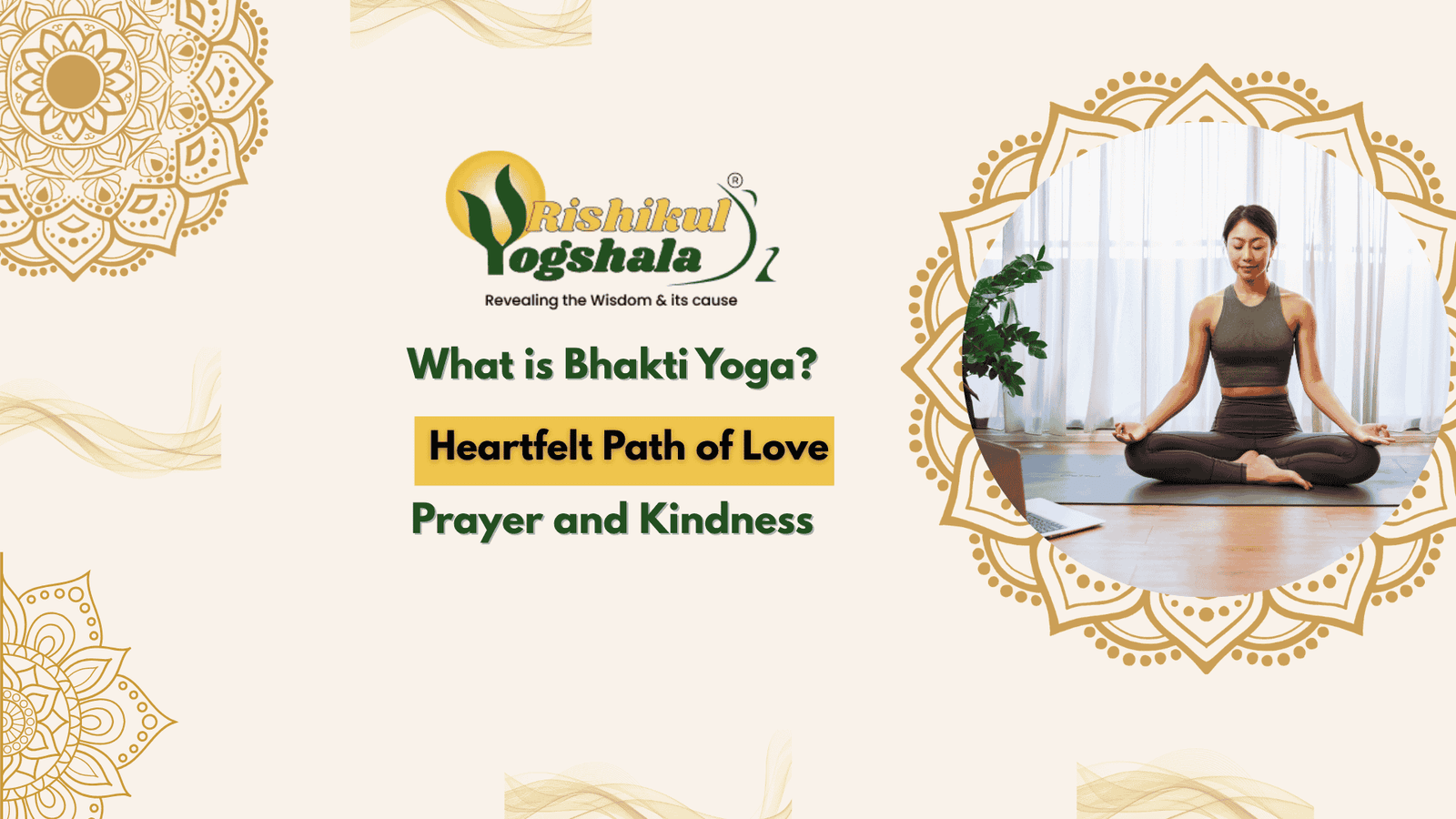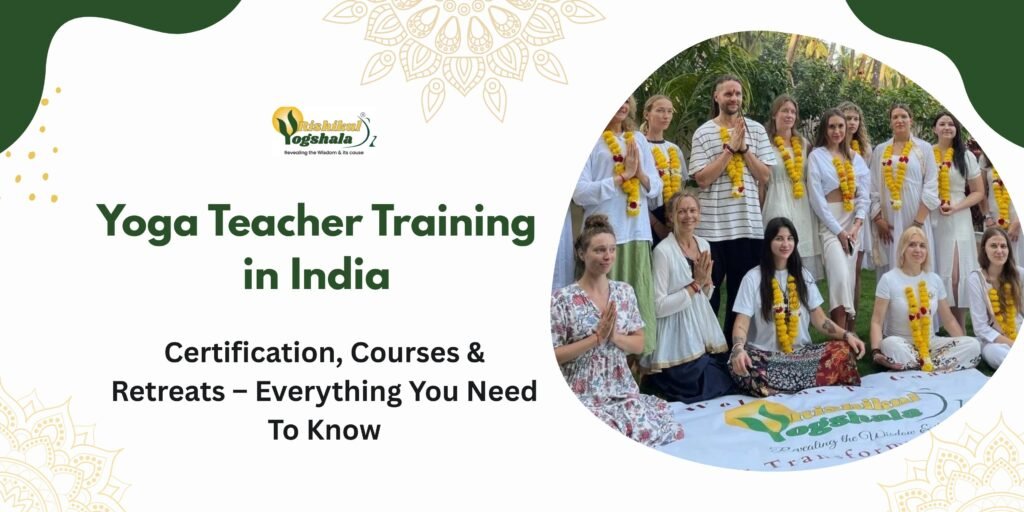What is Bhakti Yoga? A Heartfelt Path of Love, Prayer, and Kindness
- Blog
- /
- Yoga Philosophy and Spirituality
- /
- What is Bhakti Yoga?...

Did you know that feeling great love for God can cause your heart to overflow with joy? That is the path of Bhakti Yoga— the ancient path of devotion and love for the divine.
Although there are several types of yoga that concentrate on the positions or just being quiet and meditating, Bhakti Yoga is more about building a personal relationship with God through love, prayer, chanting, and serving and helping all beings. But where did this wonderful practice come from? How did it come to be expressed through ancient scriptures to the modern Hare Krishna movement, kirtans, and temple worship?
In this blog, we’ll explore:
✔ Meaning of Bhakti Yoga
✔ Its history in India’s oldest texts
✔ How saints such as Mirabai and Chaitanya Mahaprabhu disseminated it
✔ How you can practise Bhakti Yoga right now!
Whether you’re a spiritual person looking for a spiritual practice or just curious about what it is that brahmans do when they go into sadhanas, this journey of the heart of devotion will inspire you. Let’s begin!
What is Bhakti Yoga?

Bhakti Yoga is among the four major paths of yoga, alongside Karma Yoga, Jnana Yoga, and Raja Yoga. The term “Bhakti” originates from the Sanskrit language and reflects deep devotion, love, and surrender to the divine. It emphasizes building a heartfelt connection with a higher power through prayer, chanting, and devotional acts
Unlike complicated philosophies, Bhakti Yoga is simple, love God with all your heart, and see him in everyone. It doesn’t demand strict rituals or deep meditation; even singing a devotional song with pure love counts as Bhakti! For Bhakti Yoga, you don’t have to sit for hours in silence or need a scholar to perform Bhakti Yoga. If you offer a flower with love, chant a mantra and help others who are in need. It is said to remove all the ego within us, helps bring peace, gives hope and meaning to life. It reminds us to slow down, trust the divine and live life with love and gratitude
Key Features of Bhakti Yoga:
Emotional Connection: It is more valuable to love God than to obey rules.
No Discrimination: It is open to all without any exception—male and female, rich and poor, educated and uneducated.
Forms: Worship through prayer, chanting of mantra (Japa/Kirtan), Seva (service) and listening to spiritual stories.
The Ancient Roots of Bhakti Yoga
A Little History of Bhakti Yoga
1. Where Bhakti Yoga Began
The concept of Bhakti (worship) originated in the Vedas (c.1500-500 BCE), where people were praying to the Gods with mantras. The old spiritual texts guide us to have more of a personal, intimate connection with God, not to focus too much about rituals and focus more about inner love with god.
2. The Bhagavad Gita and the Path of Devotion
However, for the bhakta, the person who has such a bhakti devotion, the Bhagavad Gita deeply cares for your inner, intuitive life.
The Bhagavad Gita (c. 500 BCE) is the foundational book in which Lord Krishna teaches Arjuna about Bhakti. Krishna says,
Love Me, serve Me, surrender to Me – then you will come to Me. (Gita 9.34)
He also explains that it’s impossible to stop participating in life altogether, but It is still possible to live life with dedication and love. That’s real Yoga.
3. The Bhakti Movement (7th–17th Century)

Bhakti was practised in India by many saints from the 7th century. They ain’t care about no caste or no complex rituals. They felt that anyone could love God.
Famous Bhakti Saints:
Mirabai – A princess who gave up her earthly possessions to sing the praise of Krishna.
Tulsidas – Wrote the Ramcharitmanas, an epic book on Lord Rama.
Chaitanya Mahaprabhu – Made Hare Krishna kirtan popular and famous.
Kabir, Surdas, and Tukaram penned poetry of love towards God. They made spirituality easy and accessible for everyone.
4. How People Practice Bhakti Yoga Today
1. Kirtan & Bhajans – Singing songs and chants about God. People gather around at temples, at home or at any event, to sing with love and devotion, mostly with drums, harmonium or tabla. In Kirtan and bhajans, it is not about how well you sing, it is about how deeply you feel
Example: “Hare Krishna, Hare Rama”
2. Japa (Mantra Meditation) – Repeating God’s name using a bead string (like “Om Namah Shivaya”).
3. Seva (Service) – Doing kind acts without expecting anything. Like helping others by giving clothes or necessary things to those who are in need, or serving food at a temple.
4. Reading Holy Books – Reading the Bhagavad Gita, Ramayana, or Bhagavatam to feel closer to God. These stories give guidance, lessons, and remind people what truly matters in life.
5. Temple Visits & Festivals – Going to temples and enjoying festivals like Janmashtami (Krishna’s birthday), Diwali, or Ram Navami.
5. How Bhakti Yoga Helps Your Mind and Body
Science supports Bhakti too!
✔ Reduces stress – Chanting leads to less stress and anxiety.
✔ Makes you happier – Singing releases happy hormones, which help you relax throughout the day.
✔ Improves focus – Mantra meditation helps you concentrate.It builds your focus power and helps you to stay present in the moment
✔ Builds community –Helps you connect with people with the same interests
Symbols and Offerings in Bhakti Yoga: More Than Rituals

Why Simple Offerings Matter in Bhakti Yoga
- People think one should perform difficult and big rituals or go to temples to show their love to god. Bhatki Yoga tell even the smallest gestures, done with love and true heart, is enough. It is not about what and how much you give; it is about the true love and passion you put into it.
- For example, offering just one flower, lighting a small diya (lamp), or placing a fruit in front of your home altar can be a beautiful act of devotion. Even if you don’t have anything fancy, you can simply fold your hands, close your eyes, and say “thank you” to God. That is Bhakti.
- Many people keep a small photo or idol of the deity they feel close to, like Krishna, Rama, Shiva, or even just a symbol like a light or nature. They might give it some water in the morning, decorate it with a leaf or flower, or just sit in front of the photo and remember god and show gratitude. These actions might seem small, but they create a gentle feeling of connection inside.
- In Bhakti Yoga, what matters most is the feeling behind your action. You don’t need perfect words or rituals. You only need silent love, even if it’s only for a few seconds a day. When you offer something with a soft heart—even if it’s just a smile or a kind thought—it becomes something sacred.
So the next time you want to connect to something higher, try to just give what you can that is around you — a leaf, a bowl of water, a sweet fruit or even a silent prayer. These little things can add peace, comfort and joy of being to your daily living.
Sacred Eating: How Food Becomes an Act of Devotion
And did you know that even how you cook, and how you eat, can be Bhakti Yoga? There are many devotional traditions that believe making food with love and offering it to God before eating it is a beautiful thing. This is known as prasadam—food that’s been offered and then shared
It’s not about fancy meals. Even a single roti or bowl of rice turns special when you cook it lovingly, think of God while cooking and offer it in your mind or at your altar It’s a way of saying, “Everything I have is yours.”
Eating becomes a gentle reminder that life is a gift. You chew slowly, feel thankful, and treat your body like a temple. When you share that food with family, neighbours, or even animals, it turns into a deeper act of kindness and connection. All these small habits convert your daily tasks.
Frequently Asked Questions
Q1: Do I have to be Hindu to follow Bhakti Yoga?
No! Anyone can love God. You can see God as Krishna, Jesus, Allah, or just as Light or Energy.
Q2: Can I do Bhakti Yoga where I live?
* Try chanting for 5 minutes each day.
* Listen to devotional songs while you do housework.
* Keep a tiny picture or statue of God and give it flowers or sweet.
Q3: What if I don’t feel a bond with God?
No problem. Begin with tiny steps—light a candle, whisper a short prayer, or listen to devotional music. Love gets bigger as time goes on.
Q4: Is Bhakti Yoga just for touchy-feely people?
Nope! Even people who are logical can find it helpful. Saying mantras is easy and down-to-earth.
Q5: How’s Bhakti Yoga not the same as prayer?
Prayer is often like asking for favors. Bhakti is just loving God because God exists, not because of what God hands out.

MEDITATION, INSPIRATIONAL AND SPIRITUAL GUIDE
Yogi Gangesha Chaitanya is a master of Yoga Philosophy, Meditation, Pranayama, and Spiritual Guidance, trained under Swami Rama and renowned institutions like the Himalayan Tradition and Sri Aurobindo Ashram. With expertise in Kundalini Yoga and meditation, he mentors students in 200-hour and 300-hour Yoga Teacher Training programs, guiding them toward inner awareness, spiritual growth, and a deeper understanding of yoga.
View Instagram Profile









